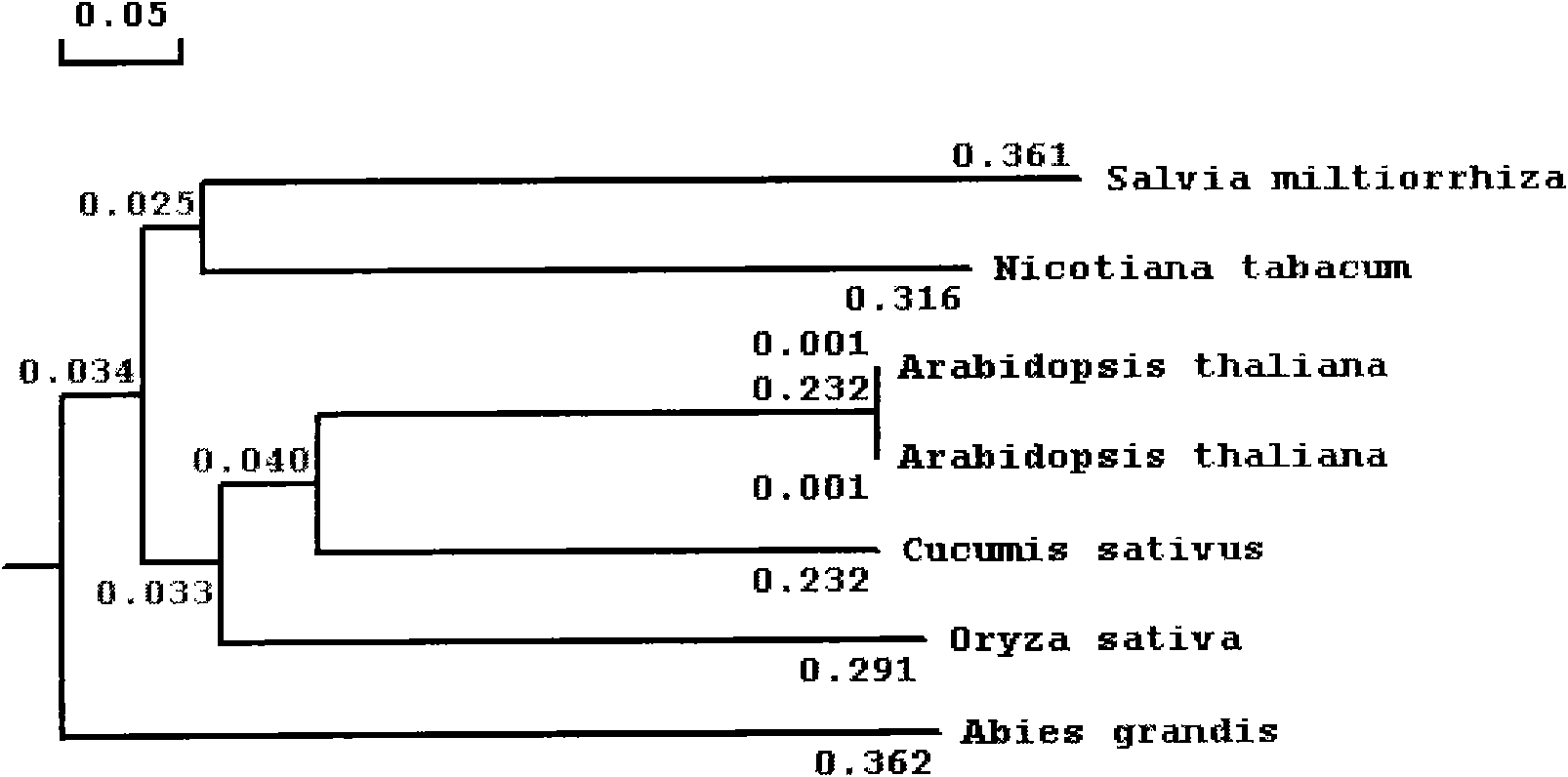Gene for generating related diterpene synthase together with tanshinone type compound as well as encoding product and application thereof
A technology of diterpene synthase and compound, which is applied in the field of diterpene synthase gene and its coded product and application in the biosynthesis of tanshinone compounds, and can solve the problems of no related reports
- Summary
- Abstract
- Description
- Claims
- Application Information
AI Technical Summary
Problems solved by technology
Method used
Image
Examples
Embodiment 1
[0024] Example 1. Preparation of Salvia miltiorrhiza cDNA chip:
[0025] 1. Isolation and detection of total RNA of Salvia miltiorrhiza
[0026] Take 2 g of Shaanxi Shangluo salvia (Salvia Miltiorrhiza Bge) roots, quickly grind into powder with liquid nitrogen in a mortar, and quickly transfer to 10 mL of extraction buffer preheated at 65 °C (CTAB (W / V) 2%, Tris-HCl (pH8.0)100mmol·L -1 , EDTA 25m mol·L -1 , NaCl 2.0mol·L -1 , PVP402%, spermidine 0.5g / L, mercaptoethanol 2%), fully shaken and mixed; extracted twice with an equal volume of chloroform, and centrifuged at 7500g for 15 minutes. Add 1 / 4 volume of 10M LiCl to the supernatant, mix well and place it at 4°C to precipitate overnight; centrifuge at 7500g for 20 minutes, use 500μL SSTE (SDS 0.5%, NaCl 1mol·L for the precipitation) -1 , Tris-HCl (pH8.0) 10mmol·L -1 , EDTA 1mmol·L -1 , dissolve at 65°C for 5 minutes. Extracted with an equal volume of chloroform, centrifuged at 13,000g for 5 minutes; added 2 volumes of ...
Embodiment 2
[0036] Example 2: Cloning of diterpene synthase gene in Salvia miltiorrhiza:
[0037] 1. Preparation of experimental materials
[0038] The hairy roots of Salvia miltiorrhiza were induced by Ri-plasmid transformation by direct infection with Agrobacterium rhizogenes 15834. Take the hairy roots of Salvia miltiorrhiza preserved in 6-7V solid medium (without hormones), inoculate 2g wet roots in a 500mL conical flask containing 200ml of hormone-free 6-7V liquid medium under aseptic conditions for the following steps. Subculture, cultured to 18d as the test material. The culture conditions were 25°C, 110-120 r·min-1, and cultured in the dark.
[0039] 2. Preparation and processing of elicitors
[0040] Preparation of yeast extract (ycast extract, YE) biological elicitor: Dissolve 25g of yeast extract in 125mL of distilled water, add 100mL of absolute ethanol, put it in a refrigerator at 4°C for 4 days, pour off the supernatant, and colloidally precipitate Dissolve in 125mL dist...
Embodiment 3
[0060] Embodiment 3, the bioinformatics analysis of SmKSL gene sequence:
[0061] The length of the full-length cDNA of the Salvia diterpene synthase gene SmKSL involved in the present invention is 2110 bp, and the detailed sequence is shown in Sequence 1 in the sequence table, wherein the complete open reading frame is located at 192-1979 bp. The full-length cDNA sequence of Salvia miltiorrhiza was searched for nucleotide homology in Non-redundant GenBank+EMBL+DDBJ+PDB and Non-redundant GenBank CDS translation+PDB+Swissprot+Superdate+PIR database with BLAST program, the result nucleotide No homologous sequence was found at the level, it can be seen that it is very difficult to clone the gene using conventional degenerate primers. The comparison analysis of this gene at the amino acid level showed that the amino acid sequence of the protein encoded by the SmKSL gene of Salvia miltiorrhiza had low homology with other species, and had the highest homology with the amino acid seq...
PUM
 Login to View More
Login to View More Abstract
Description
Claims
Application Information
 Login to View More
Login to View More - R&D Engineer
- R&D Manager
- IP Professional
- Industry Leading Data Capabilities
- Powerful AI technology
- Patent DNA Extraction
Browse by: Latest US Patents, China's latest patents, Technical Efficacy Thesaurus, Application Domain, Technology Topic, Popular Technical Reports.
© 2024 PatSnap. All rights reserved.Legal|Privacy policy|Modern Slavery Act Transparency Statement|Sitemap|About US| Contact US: help@patsnap.com










